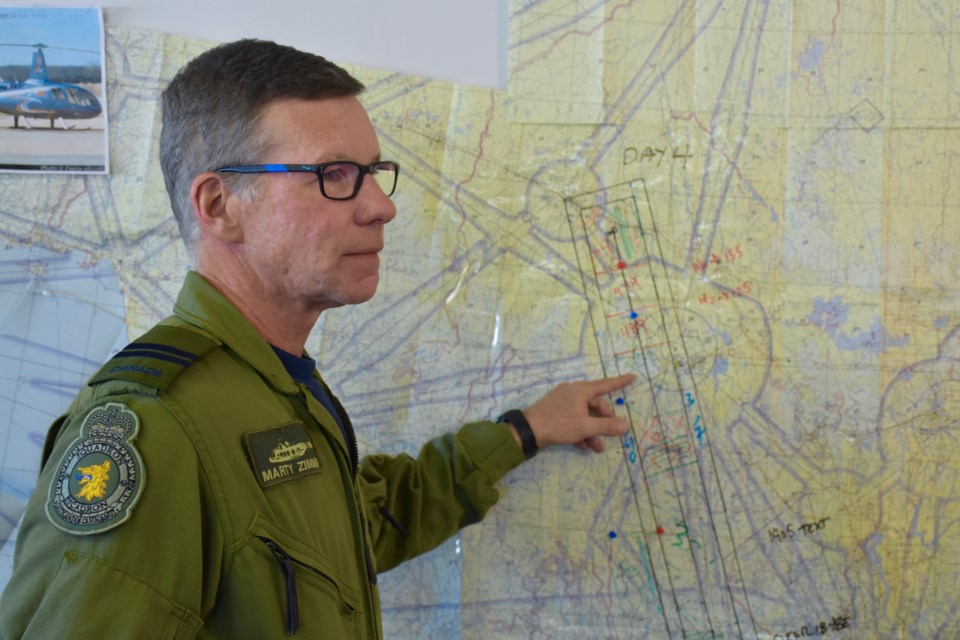The search master of the efforts to locate a missing Kapuskasing couple is optimistic.
Today at the Timmins Victor M. Power Airport, where the search and rescue operation is being headquartered, Capt. Martin Zimmer provided a number of reasons to be optimistic about locating Nicole Blais, 47, and Jody Blais, 49.
“With any missing aircraft, obviously time is of the essence...so that’s why we’re putting a lot of resources in right now, but obviously we will continue to search until we determine the chances of survival are no longer there, but we’re very optimistic right now,” Zimmer said.
“We know from the family that the pilot is experienced and he also has quite a bit of survival equipment on board, so we’re very optimistic at this point that we’re still going to find the couple, so we’re working towards that.”
The Kapuskasing couple was last seen leaving Sudbury via helicopter March 4 around 7 p.m. and did not arrive at their destination, a hangar in Fauquier.
The missing helicopter is a grey Robinson R66 with white and orange trim.
Earlier today, the Joint Rescue Coordination Centre (JRCC) Trenton and the Royal Canadian Air Force (RCAF) declared a major search and rescue operation. This will allow for more Royal Canadian Air Force (RCAF) and Civil Air Search and Rescue Association (CASARA) personnel and assets to help with the search.
There are about 50 military and civilian personnel working in the search headquarters and nine aircraft are involved right now.
Two Hercules, three Griffon helicopters, three CASARA aircraft are currently being used.
Zimmer said they are also working to bring in a maritime aircraft equipped with sensors “so that we can actually fly the track and look for heat sensor areas and also it will pick up metal and stuff like that”.
With good weather today, he said they are trying to get as much coverage as possible.
“Right now, as you can see, the weather is very good. It’s not really impacting the search at all, we’re looking at some weather coming in tomorrow, a snowstorm, so we’re trying to basically provide as much coverage as we can today with the indication that maybe we might not be able to get as many aircraft up tomorrow,” he said.
So far there has been no emergency locator transmitter (ELT) signal.
Zimmer said there could be a number of reasons for that, including that it’s not turned on, the antenna is broken, or there isn’t one on board.
He noted the ELT is just one aspect of the search.
They are doing a visual search from the air, looking at cell phone contact, and talking to family members to understand the pilot’s typical characteristics while flying. If someone saw an aircraft flying the route from Sudbury to Kapuskasing Monday from 7 - 9 p.m., they want to hear from you.
“We also know he has a GPS on board and his intention when he normally flies is to fly direct,” he said.
There have been three or four tips received from the public.
“But right now we’re concentrating on cell phone coverage, we’re looking at some of the towers and whether the phones were pinging off a specific tower...we know that the phones were in the aircraft so that’ll give us an indication of approximately how far he’s gone,” said Zimmer.
About two-thirds of the way into the flight, which is around the Timmins airport, he said one of the people in the helicopter was talking to a family member via text.
While he hopes that means the aircraft got at least that far into the route, he said they can’t take part of the search area out as they don’t know if the pilot turned around due to weather or other reasons.
“The family tells us that the pilot would typically call there (the Timmins airport) when he’s flying by and he did not, so that gives an indication that he may or may not have gone that far,” he said.
Even though the weather has been good for the search so far, the terrain is a factor for searchers.
As such, Zimmer said helicopters, which can go slow and low, are the most valuable at this point.
“We’re not actually looking for an aircraft, we’re looking for a change in the environment that indicates the aircraft may have gone through there. Unless he landed in the open area and at this point because of the coverage we’ve already done, we kind of feel that that may not be the case,” he said.
Family and friends have also been calling out for volunteers on social media and searching via snowmobile.
The main search headquarters is working “very closely” with the family, according to Zimmer.
“We know that they’ve had a lot of volunteers that are helping them search, so we’re keeping close contact and trying to help them out as they’re providing information to us as they get it as well,” he said.
“We understand how the family feels and we’ve got a lot of professionals here and we’re doing everything we can to try to bring their loved ones home. We’re hopeful at this point and hopefully we can do that.”
As the efforts continue, people are being asked not to fly drones or unmanned aerial vehicles (UAVs) in the search area.
According to the DND, "it significantly affects our ability to safely carry out our SAR mission."
If you've seen a helicopter matching the description or have seen signs of a possible crash site, members of the public can call 705-268-2608 ext. 234.

